Austrian
-
Mozart - Sonata in G Major - Alto Flute
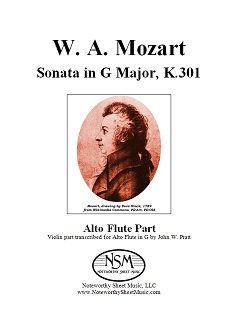 Sonata in G Major, K.301, by W. A. Mozart
Sonata in G Major, K.301, by W. A. MozartTranscribed for Alto Flute and Piano by John W. Pratt
Alto Flute Part, PDF $4.99
This sunny sonata has two movements, an up-beat Allegro con spirito followed by an Allegro that is actually a sprightly minuet with a trio section in the minor, almost as near to a Beethoven scherzo as a Haydn minuet. The violin leads as often as the piano, including at the beginning and throughout the trio, but is largely spared Mozart's typical keyboard passage work. As with six other violin sonatas composed in 1778, the first of Mozart's maturity, the violin part rarely makes significant use of double stops and is in general very well suited to alto flute. In fact, K.301 was begun with flute in mind. We provide our transcribed alto flute part. The piano score is available in the public domain as a free pdf download from imslp.org/.
For additional information about the seven Mozart Mannheim sonatas and their alto flute transcriptions, please read the Mozart’s Mannheim Sonatas article written by Mr. Pratt; the article was originally published by Flute Focus and subsequently republished by NSM on our Resources – Reviews and Articles page.
Alto Flute part, 4 pages; Total, 6 pages.
Preview -
Mozart - Sonata in E-flat Major, K.302 - Alto Flute
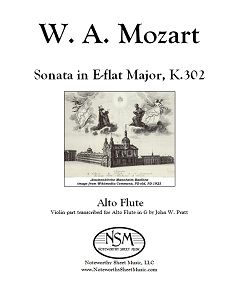 Sonata in E-flat Major, K.302, by W. A. Mozart
Sonata in E-flat Major, K.302, by W. A. MozartTranscribed for Alto Flute and Piano by John W. Pratt
Alto Flute Part, PDF $4.99
Mozart's Sonata in E-flat Major, K.302 has two movements, an Allegro and a rondo Andante grazioso. This ebullient sonata opens with a striking call to attention, much used later, which descends on the tonic triad but alternates half and quarter notes in 3/4 time, thus avoiding both square rhythm and repeated root positions on every down beat. The theme which follows is contrastingly gentle. The second movement offers a firmly forward-moving theme whose immediate repeat and final returns are variously and charmingly re-orchestrated. (excerpted from JWP's foreword to the edition)
We provide our transcription of the violin part for alto flute; the piano score is available in the public domain as a free pdf download from imslp.org/.
For additional information about the seven Mozart Mannheim sonatas and their alto flute transcriptions, please read the Mozart’s Mannheim Sonatas article written by Mr. Pratt; the article was originally published by Flute Focus and subsequently republished by NSM on our Resources – Reviews and Articles page.
Alto Flute part, 5 pages; Total, 8 pages.
Preview -
Mozart - Sonata in C Major, K.303 - Alto Flute
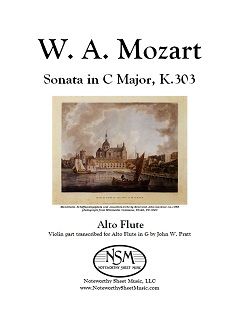 Sonata in C Major, K.303, by W. A. Mozart
Sonata in C Major, K.303, by W. A. MozartTranscribed for Alto Flute and Piano by John W. Pratt
Alto Flute Part, PDF $4.99
Both movements of Mozart's Sonata in C Major, K.303 are quite different from others of his 'Mannheim' set. The unusual first movement is in sonata form mixing retro and novel features—the whole first subject and transition to the dominant are adagio and considerably varied in the recapitulation, and there is no development. The second movement is an old-style minuet (without trio), ending with a pedal point terminating in a tremble. Our transcription for alto flute shifts the violin part to a different octave in three short segments and we have substituted musically appropriate alternatives for the double stops. We provide our transcription of the violin part for Alto Flute in G; the piano scoreis available in the public domain as a free pdf download from imslp.org/.
Alto Flute part, 5 pages; Total, 8 pages.
Preview -
Haydn - Adagio from Sym. No.24 - Afl & Pf
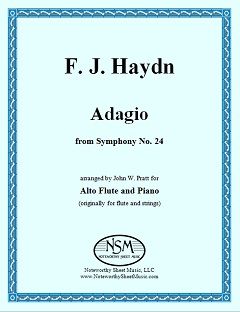 Adagio from Symphony No.24, by F. J. Haydn
Adagio from Symphony No.24, by F. J. HaydnArranged for Alto Flute and Piano by John W. Pratt
Alto Flute Part and Piano Score, PDF $6.00
We offer a flute and piano edition of the gorgeous second movement Adagio for solo flute accompanied by strings from Haydn's Symphony No.24. An arrangement for alto flute that is mellower than that for flute but also extremely beautiful is obtained by lowering the pitch a minor third. Haydn's flute part needs no other change, nor does the cadenza that was written by Mr. Pratt for our C-flute edition. The string parts have been adapted to piano sonority in a number of ways, as well as transposing them in this alto flute edition.
Alto Flute part, 2 pages; Alto Flute & Piano score, 4 pages; Total, 10 pages.
Preview -
Schubert - Auf dem Strom - Voice/Bass Flute/Pf
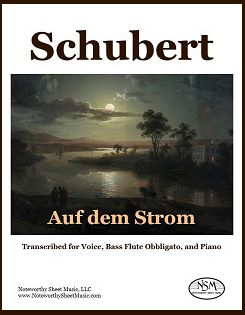 Auf dem Strom, Op.119, by Franz Schubert
Auf dem Strom, Op.119, by Franz SchubertObbligato transcribed for Bass Flute by C. A. Vater
Piano Score and Parts for Voice and Bass Flute, PDF $9.50
Preview
The great Austrian composer Franz Peter Schubert (1797-1828) was a master at creating extremely beautiful, melodic, emotional lieder. His song Auf dem Strom (On the River) provided a musical setting for the text of the eponymous poem written by the German poet and music critic Ludwig Rellstab. The lyrics tell the story of a sad parting, of the yearning and loneliness that sets in as the narrator bids farewell to a loved one on shore, while his river journey carries him away towards the sea. The premier performance of Auf dem Strom took place in Schubert's 1828 public concert, during which the obbligato part was played by Josef Lewy on horn, the instrument for which the obbligato was written and which undoubtedly can provide an appropriately mournful, sentimental character to the piece. However, an alternate obbligato version for cello was also published. Now, with all respect, and at the suggestion of our flutist colleague Peter H. Bloom, we offer a bass flute version of the obbligato. Most of the transposed horn part falls nicely within the sweet range of the bass flute, and very few adaptations were required. Though clearly having different sonic qualities than a horn, the bass flute lends a forlorn, haunting, earthy tone that can well do justice to this Schubert song. After giving the bass flute obbligato a try, Mr. Bloom commented: "Fabulous! // The tone-color of the bass flute for this number is gorgeous." -
Mozart - Sonata in A Major, K.305 - Alto Flute
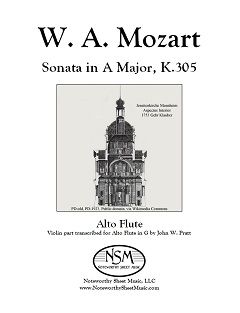 Sonata in A Major, K.305, by W. A. Mozart
Sonata in A Major, K.305, by W. A. MozartTranscribed for Alto Flute and Piano by John W. Pratt
Alto Flute Part, PDF $3.99
Mozart's Sonata in A Major, K.305 is perhaps the most completely extroverted of the Mannheim sonatas. Like K.302, it opens with four emphatically tonic bars, followed by a gentle, linear four-bar theme, all immediately repeated. The second movement of K.305 is the only movement of the Mannheim sonatas in theme-and-variations form. It is far from routine. The theme has an unusual variety of rhythms and accompaniment figurations; the 32nd-note variation is the very first, not a later one; the minor variation is at the prevailing tempo, not slow; and a brief but telling piano cadenza interrupts the antepenultimate variation's peroration. (excerpted from JWP's foreword to the edition)
We provide the transcribed alto flute part—the piano scoreis available in the public domain as a free pdf download from imslp.org/.
Alto Flute part, 4 pages; Total, 6 pages.
Preview -
Mozart - Sonata in D Major, K.306 - Alto Flute
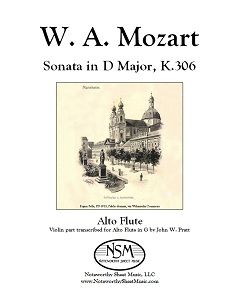 Sonata in D Major, K.306, by W. A. Mozart
Sonata in D Major, K.306, by W. A. MozartTranscribed for Alto Flute and Piano by John W. Pratt
Alto Flute Part, PDF $9.99
Mozart's Sonata in D Major, K.306 is by far the longest and showiest of the 'Mannheim' sonatas, with three large-scale movements, some quasi orchestral textures, much doubling, and brilliant passage work. The first movement's development expands four transitional bars of the exposition into a far-reaching harmonic excursion. The recapitulation begins with the second subject and returns to the first so late it amounts to a coda, the only instance of 'mirror' sonata-form in the Mannheim set. In contrast, the second movement, Andante cantabile, has a structurally orthodox sonata form, compressing and ornamenting the themes in the recapitulation, as befits the tempo. The finale is an elaborate rondo alternating between allegretto in 2/4 and allegro in 6/8. (excerpted from JWP's foreword to the edition)
We provide our transcribed alto flute part; the piano scoreis available in the public domain as a free pdf download from imslp.org/.
Alto Flute part, 10 pages; Total, 12 pages.
Preview -
Mozart - Sonata in C Major, K.296 - Alto Flute
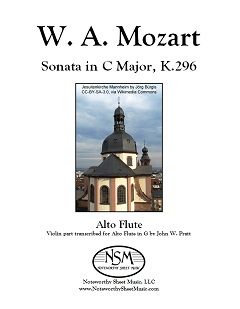 Sonata in C Major, K.296, by W. A. Mozart
Sonata in C Major, K.296, by W. A. MozartTranscribed for Alto Flute and Piano by John W. Pratt
Alto Flute Part, PDF $6.99
Mozart composed K.296 in 1778 under the same creative impulse as the other Mannheim violin sonatas, K.301‒306, but published it later, in 1781, with five other three-movement sonatas. He dedicated it to his Mannheim landlord's 15-year old daughter, Therese-Pierron Serrarius, who perhaps inspired the turns lightening the opening fanfares, quick trills in the first theme, and contrasting textures and sparkling interplay between the instruments in the first movement. The second movement is a beautiful arietta with wonderful opportunities for the alto flute to both present and accompany the melody. In the concluding Rondo, in sonata-rondo form, the instruments repeatedly swap the theme and much of the episodic material. ―J. W. Pratt
We provide our transcription of the violin part for alto flute; the piano score is available in the public domain as a free pdf download from imslp.org/.
For additional information about the seven Mozart Mannheim sonatas and their alto flute transcriptions, please read the Mozart’s Mannheim Sonatas article written by Mr. Pratt; the article was originally published by Flute Focus and subsequently republished by NSM on our Resources – Reviews and Articles page.
Alto Flute part, 7 pages; Total, 10 pages.
Preview -
Haydn - Fantasia in C Major - Flute & Alto Flute
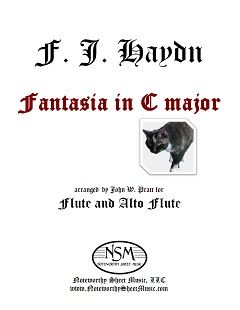 Fantasia in C major, by F. J. Haydn
Fantasia in C major, by F. J. HaydnArranged as a Duet for Flute and Alto Flute by John W. Pratt
Flute Part, Alto Flute Part, and Score ― PDF $12.99
Fantasia in C major (Op.58; Hob. XVII:4) was written by Haydn in 1789 for the pianoforte. Based on a folk song about a farmer's wife chasing her cat, one can easily imagine in the music kittenish scampering, stealthy approaches, unexpected pounces, and mad chases with abrupt changes of direction. The style and playfulness of the piece are beautifully suited to the agility and sparkle of flutes. The transcription is able to capture the feel Haydn intended, with new coloring, while at the same time affording flutists the joy of experiencing the work first-hand. (adapted from JWP's foreword to the edition)
Please click the Preview button to see p1-2 of the mini-Score (in concert pitch). After opening the file, adjust the orientation using "View - Rotate View - Clockwise" in your pdf reader program.
Flute part, 6 pages; Alto Flute part, 7 pages; Mini-score, 6 pages; Total, 22 pages.
Preview -
Haydn – Adagio from Symphony No.24 – trans. Solo Flute and Flute Choir
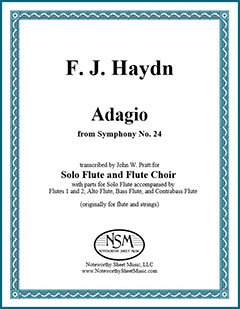 Adagio from Symphony No.24 by F. J. Haydn
Adagio from Symphony No.24 by F. J. HaydnTranscribed for Solo Flute accompanied by Flute Choir, by John W. Pratt (originally for flute and strings)
Score and Parts for Solo Flute, Flutes 1 and 2, Alto Flute, and Bass Flute/Contrabass Flute, PDF $7.99
Haydn wrote his Symphony No.24 in 1764. Its second movement is a beautiful Adagio for flute solo accompanied by strings. The string parts are simple, with no double stops or extreme high notes, so they can be played comfortably by corresponding members of the flute family, except for a few low notes. This transcription for flute choir is therefore straightforward except that the alto flute sometimes plays violin notes that C-flutes cannot play or can use support playing, and similarly the bass flute plays some viola notes instead of or in addition to the alto flute playing them. Notes taken from the cello in its lowest octave have been raised an octave for bass flute, but there are fewer than one might expect. Perhaps one reason is that Haydn expected a (string) bass to be doubling the cello an octave lower, playing from the same part. If a contrabass flute is available, it can double the bass flute similarly, serving even more to enrich the sound. —adapted from JWP’s preface to the edition
Listen to a computer-generated audio sample.
Score, 5 pages; Parts for Solo Flute, 2 pages; Flutes 1 and 2, 2 pages; Alto Flute, 1 page; Bass Flute/Contrabass Flute, 1 page; Total 19 pages.
Preview -
Haydn - Fantasia in C Major - Flute & Clarinet
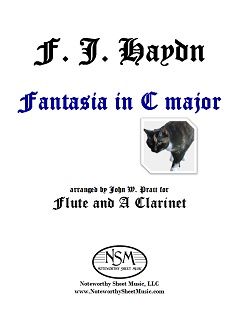 Fantasia in C major, by F. J. Haydn
Fantasia in C major, by F. J. HaydnArranged as a Duet for Flute and Clarinet by John W. Pratt
Flute Part, A Clarinet Part, and Mini-Score ― PDF $12.99
Fantasia in C major (Op.58; Hob. XVII:4) was written by Haydn in 1789 for the pianoforte. Based on a folk song about a farmer's wife chasing her cat, one can easily imagine in the music kittenish scampering, stealthy approaches, unexpected pounces, and mad chases with abrupt changes of direction. The style and playfulness of the piece lend themselves well to flute and clarinet. The transcription is able to capture the feel Haydn intended, with new coloring, while at the same time affording flutists and clarinetists the joy of experiencing the work first-hand. (adapted from JWP's foreword to the edition)
Flute part, 6 pages; Clarinet in A part, 6 pages; Mini-score in concert pitch, 6 pages; Total, 24 pages.
Preview -
Mozart - Concerto in E-flat major, K417 - Alto Flute & Piano
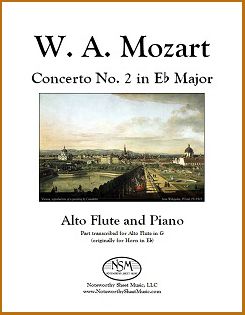 Concerto No.2 in E-flat major, K.417, by W. A. Mozart
Concerto No.2 in E-flat major, K.417, by W. A. MozartTranscribed for Alto Flute (from horn and piano arrangement) by C.A.Vater
Piano Score and Alto Flute Part, PDF $9.99
Mozart wrote his Concerto No. 2 in E-flat major for Horn and Orchestra for his good friend, the virtuoso horn soloist Joseph Leutgeb (c.1745-1811), who became first horn in the orchestra of the Salzburg archbishop in 1770. The concerto was completed in 1783. Its movements are light, joyous, and teeming with melody: a wide-ranging opening allegro, a slow middle movement, and a final rondo. The second movement Andante is particularly lyrical and beautiful, whereas the concluding Rondo is quite comic with an obvious hunting theme.
The concerto was arranged for horn and piano by Henri Kling (1842-1918), horn player, composer, conductor, and professor. We used the Kling arrangement, which was published ca.1890 and is now in the public domain, as the basis of our transcription of the concerto for alto flute and piano. We introduced only minor changes to the solo horn line to adapt it for alto flute, and those alterations were made with sensitivity and the intention of preserving Mozart's inspired creation to the fullest extent possible.
Alto Flute part, 4 pages; Piano Score, 16 pages; Total, 22 pages.
Preview -
Mozart – Sonata in E minor – Clarinet (and Piano)
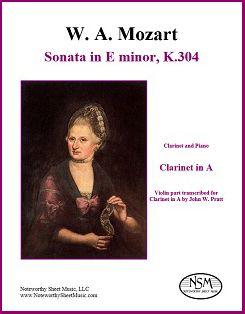 Sonata in E minor, K.304, by W. A. Mozart
Sonata in E minor, K.304, by W. A. MozartTranscribed for Clarinet (and Piano) by John W. Pratt
Clarinet in A Part, PDF $5.99
Mozart's second group of violin sonatas, the seven "Mannheim" sonatas of 1778, were begun in Mannheim where the composer also worked on a flute commission. The violin parts rarely make significant use of double stops and are in general well suited to a wind instrument. Mozart's works in minor keys are rare and special: consider the G-minor quintet and Symphony No. 40. The K.304 sonata is his only work in E minor and it is mysteriously compelling in its simplicity. Mr. Pratt has created an excellent transcription of the Sonata in E minor, K.304 for A-clarinet. K.304 was written the same summer that Mozart's mother died, an association often pointed to and the inspiration for our cover image selection.Note that Mr. Pratt's transcription offers the advantage of being in the original key, and that we provide the A-clarinet part only. The clarinet part works perfectly with the piano part in Mozart's score for piano and violin, which is in the public domain and readily available on imslp.org, free of charge.
For additional information about the seven Mozart Mannheim sonatas and Mr. Pratt's previous transcriptions of them for alto flute, please read his article Mozart's Mannheim Sonatas, which was originally published by Flute Focus and subsequently republished by NSM on our Resources – Reviews and Articles page.
Preview
Clarinet part, 5 pages; Total, 8 pages. -
Mozart - Concerto in Eb Major, K.447 - Alto Flute
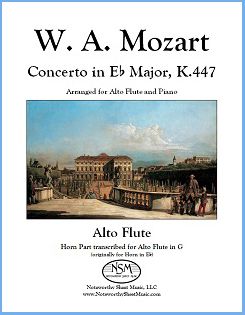 Concerto in E-flat Major, K.447, by W. A. Mozart
Concerto in E-flat Major, K.447, by W. A. MozartTranscribed for Alto Flute (from horn and piano arrangement) by C.A.Vater
Alto Flute Part, PDF $5.99
Wolfgang Amadeus Mozart (1756-1791) wrote four horn concertos for his good friend Joseph Leutgeb (1732-1811). Leutgeb was a virtuoso horn player, who served as principal horn in Salzburg and thus became a colleague of Leopold Mozart, during the young Wolfgang's early years. Leutgeb appears to have remained a friend and inspiration for W. A. Mozart throughout the composer's life.
The Mozart horn concertos are delightful, joyous works. The third horn concerto, K.447, like two of the three others, was written in the key of E-flat major. It is thought to have been composed in 1787. The work is in typical concerto form, consisting of three movements—an Allegro, a Romanze, and another Allegro, which together have an average performance duration time of approximately 15 minutes.
K.447, Concerto for Horn in E-flat major for Horn and Orchestra, is scored for solo horn in E-flat, with two clarinets, two bassoons, and strings. Henri Kling (1842-1918), a horn player who was also a composer, conductor, and professor, arranged the concerto for horn and piano. His transcription was published by Breitkopf und Härtel, n.d. (ca. 1890). We used the Kling edition, now in the public domain and available as a free pdf download from imslp.org, to create a transcription of the horn part for alto flute. Our edition incorporates adjustments that account for differences in range and sonority between the alto flute and horn, while striving to maintain the style and character of the original composition.
We provide the alto flute part only; the piano score (horn and piano) by Henri Kling is freely available from imslp.org.
Alto Flute part, 5 pages; Total, 8 pages.
Preview -
Mozart - Concerto in Eb Major, K.495 - Alto Flute
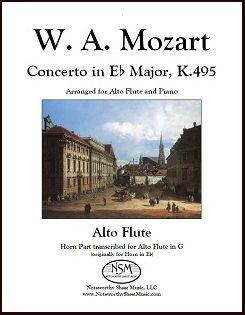 Concerto in E-flat Major, K.495, by W. A. Mozart
Concerto in E-flat Major, K.495, by W. A. MozartTranscribed for Alto Flute (from horn and piano arrangement) by C.A.Vater
Alto Flute Part, PDF $7.99
Mozart's Horn Concerto No.4, K.495, was composed in 1786 and scored for solo horn, with two oboes, two horns, and strings (bassoon ad libitum). The work consists of three movements—Allegro moderato, Romanza-Andante, and Rondo-Allegro vivace—with the rousing Rondo clearly evoking a hunt scene. The horn player Henri Kling (1842-1918) created arrangements of all the Mozart horn concerti for horn and piano. His transcription of K.495 was published by Breitkopf und Härtel, n.d. (ca. 1882). We used the Kling edition, now in the public domain and available as a free pdf download from imslp.org, to create a transcription of the horn part for alto flute. Our edition incorporates adjustments that account for differences in range and sonority between the alto flute and horn, while striving to maintain the style and character of the original composition.
We provide the alto flute part only; the piano score (horn and piano) by Henri Kling is freely available from imslp.org.
Alto Flute part, 7 pages; Total, 10 pages.
Preview -
Mozart - Sinfonia Concertante - Fl/Cl/Pf
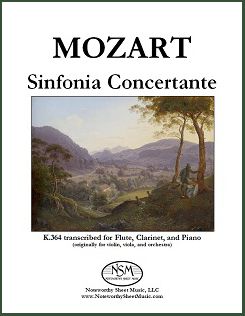 Sinfonia Concertante, K.364, by Wolfgang Amadeus Mozart
Sinfonia Concertante, K.364, by Wolfgang Amadeus MozartTranscribed for Flute, Clarinet, and Piano by John W. Pratt
(originally for Violin, Viola, and Orchestra)
Piano Score, Flute & Clarinet Parts, PDF $17.99
Excerpted from the Foreword by J. W. Pratt: "The idea that every piece, especially a major one, can be satisfactorily transcribed for whatever instruments one would like is one I firmly reject. However, a trio arrangement of this Sinfonia Concertante for flute, clarinet, and piano can, I believe, capture and present in a new light many of the wonders of this great work, even the wonders of its sonorities..... In the arrangement here, the flute and clarinet almost always play either a solo part or an orchestral part with only octave changes..... For the piano, on the other hand, straightforward orchestral reduction is often ineffective and unsatisfying, and that would certainly be true here, even with the flute and clarinet taking some wind parts. I have attempted instead to find natural piano "orchestrations" as alternatives to Mozart's orchestral layouts, especially where the full orchestra is playing..... Such effects, often heightened on returns, are better suited to the piano's capabilities and its role as a member of a trio than a straightforward reduction would be..... The music available for flute, clarinet, and piano includes surprisingly few major works. The purpose of our arrangement is to add a significant piece to this repertoire and to enable players and listeners to enjoy Mozart's magnificent Sinfonia Concertante in a new way."
Score, 41 pages; Flute part, 18 pages; Clarinet part, 17 pages; Total, 82 pages.
Preview -
Schubert - Rondo in B minor - Flute (and Piano)
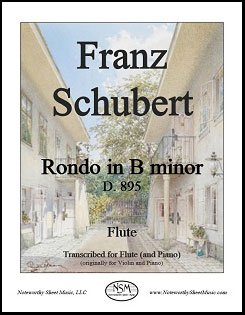 Rondo in B minor, D.895, by Franz Schubert
Rondo in B minor, D.895, by Franz SchubertTranscribed for Flute (and Piano) by J.W.Pratt and C.A.Vater
Flute Part, PDF $11.99
The Rondo in B minor, D.895 (alternatively known as Rondeau brillant) was written for violin and piano in 1826 by the great Austrian composer Franz Peter Schubert. Dedicated to the young violin virtuoso Josef Slawjk, the Rondo is demanding in both the solo and piano parts. The work consists of an Andante introduction and an Allegro rondo, and is quite long at 713 measures and typically some thirteen minutes or more in duration. Inexplicably, the piece is less familiar to players and audiences than many of Schubert’s other works. Brian Newbould, renowned composer, conductor, author, and Schubert expert, wrote of the Rondo in his treatise Schubert: The Music and the Man (University of California Press, Jan 1, 1997, p365): “Not surprisingly, perhaps, it is little known because it is seldom played. But it is also undervalued: it scintillates, dances and sings, with a blend of infectious joy, tireless energy, rhythmic zip and ‒ from time to time ‒ heart-melting turns of melody and harmony.”
These characteristics and the way the music realizes them are not only suitable to but often even suggestive of a wind instrument. Our transcription provides effective flute-friendly alternatives for the violin’s double-stops as well as for notes that fall below the flute’s range, so the piece can be played comfortably and beautifully on flute. The Rondo is virtuosic in places, showy and exciting, and overall great fun to play. The Noteworthy Sheet Music edition of our transcribed flute part does not include a re-notated copy of the score, since high-quality PDFs of the piano and violin score are freely available in the public domain and are sufficient to use along with our flute part, in lieu of violin. To download one such PDF of the score, please visit the Rondo’s page on IMSLP.Flute part, 12 pages; Total 14 pages.
Preview -
Haydn - Trio, Hob. XV:18 - arr. Woodwind Quartet
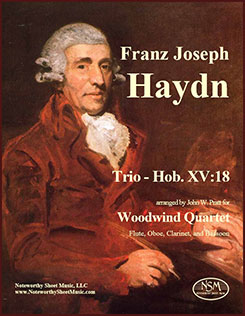 Trio, Hob. XV:18, by Franz Joseph Haydn
Trio, Hob. XV:18, by Franz Joseph Haydntransposed to B-flat major and arranged for Woodwind Quartet by John W. Pratt
Score and Parts for Flute, Oboe, B-flat Clarinet, and Bassoon; PDF $20.97
As noted in the arranger’s forward to the edition, the later piano trios of Franz Joseph Haydn (1732-1809) are superb music, but because they were written for excellent pianists and weak string players, they are dominated by the piano part. This imbalance among the parts actually makes the trios highly amenable to and effective in arrangement for woodwind quartet. Written after Haydn’s first visit to London, the Piano Trio in A major, Hob. XV:18, was first published in 1794. The first of its three movements, a flowing Allegro moderato, is unified by ingenious use of the three-note motif opening its cantabile main theme. The lovely middle Andante, in ABA form and 6/8 meter, features some luxurious ornamentation and proceeds attacca to the spirited and humorous Allegro finale. The resources of a woodwind quartet are well suited to the musical ideas of this trio, and the arrangement adapts Haydn’s piano, violin, and cello lines wonderfully to the range and sonority of the instruments used: flute, oboe, B-flat clarinet, and bassoon. This adaptation is facilitated by transposition from Haydn’s original key of A major to B-flat major. We provide parts plus a score in concert pitch.
Click to listen to computer-generated audio samples from the score; audio clips from movements I (m44.4 - m64.3), II (m0 - m4.5 & m49.6 - m54.5), and III (m36.2.2 - m48) are separated by brief pauses.
Score in concert pitch, 21 pages; Flute part, 8 pages; Oboe part, 6 pages; B♭-Clarinet part, 5 pages; Bassoon part, 5 pages; Total, 52 pages.
Preview -
Haydn - Trio, Hob. XV:25 ‘Gypsy’ - arr. Woodwind Quartet
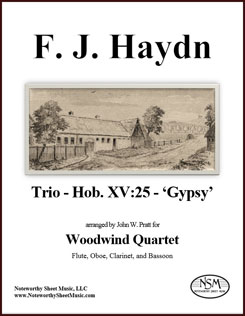 Trio, Hob. XV:25 ‘Gypsy’, by Franz Joseph Haydn
Trio, Hob. XV:25 ‘Gypsy’, by Franz Joseph Haydnarranged for Woodwind Quartet by John W. Pratt
Score and Parts for Flute, Oboe, B♭-Clarinet, and Bassoon; plus, an alternative A-Clarinet part; PDF $16.97
Short summary adapted by NSM from John W. Pratt’s foreword to the edition:The trios Hob. XV: 24-26 were, in Robbins Landon’s account (Haydn, Indiana, 1976), probably the last works Haydn delivered to his publishers before he left England in 1795. They were written for strong amateur pianists and weak string players, and although the string parts are essential for their effects on sonority, they are not terribly interesting. Such a scenario lends itself beautifully to arrangement of these piano trios for wind quartet.
Haydn labeled the finale of Hob. XV: 25 "in the Gypsies' style", and the trio became an enormous favorite. In the key of G, it opens with a particularly lovely slow movement having alternating minor and major variations. The third variation is in the relative minor (e), anticipating the key, E major, of the even slower, but subtle and melodically rich, second movement. This retardation heightens the effect of the famous finale.
We have provided alternative parts for clarinet in B-flat and in clarinet in A. Some players may wish to use the A-clarinet only in the second movement, for the sake of the friendlier key signature and perhaps also for sound, depending on the instrument.
Click to listen to computer-generated audio samples from the score; audio clips from movements I (m42-48, m72-78), II (m57-63), and III (168-190) are separated by brief pauses.
Score in concert pitch, 17 pages; Flute part, 6 pages; Oboe part, 4 pages; B♭-Clarinet part, 6 pages; Bassoon part, 4 pages; alternative part for A-Clarinet, 6 pages; Total, 56 pages.
Preview -
Mozart - Kegelstatt Trio - Alto Flute
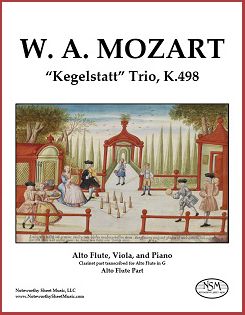 "Kegelstatt" Trio in E-flat major, K.498, by W. A. Mozart
"Kegelstatt" Trio in E-flat major, K.498, by W. A. Mozart
Transcribed for Alto Flute, Viola, and Piano by John W. Pratt, with a Program Note by Peter H. Bloom
Alto Flute Part, PDF $7.99As Editor-in-Chief of Noteworthy Sheet Music, LLC, I recently found myself in the unusual situation of having received transcriptions of the "Kegelstatt" Trio clarinet part for alto flute from two of NSM's most experienced and proficient arrangers, John W. Pratt and Peter H. Bloom. That both arrangers chose to create a "Kegelstatt" part for alto flute, and that their transcriptions were nearly identical, attests to the value of adapting this Mozart clarinet part and its natural fit for the alto flute. Our edition includes Mr. Pratt's alto flute part transcription, as well as a program note written by Mr. Bloom for his upcoming alto flute performances of the "Kegelstatt" Trio with Ensemble Aubade (Peter H. Bloom, flutes; Francis Grimes, viola; and Mary Jane Rupert, piano/harp). —cav, December, 2016
Our edition includes only the alto flute transcription of the clarinet part; the original piano score and viola part are in the public domain and may be downloaded free of charge from IMSLP.org as good quality PDFs.
Preview
Alto Flute part, 6 pages; Total, 10 pages.